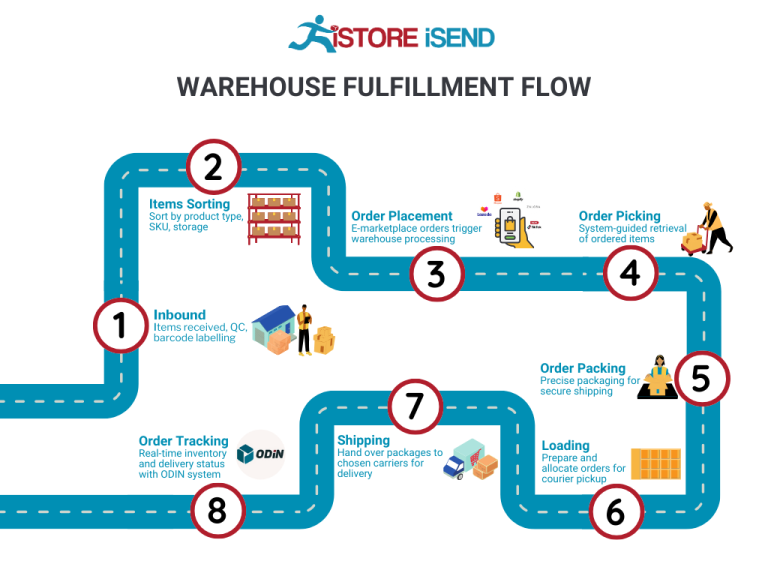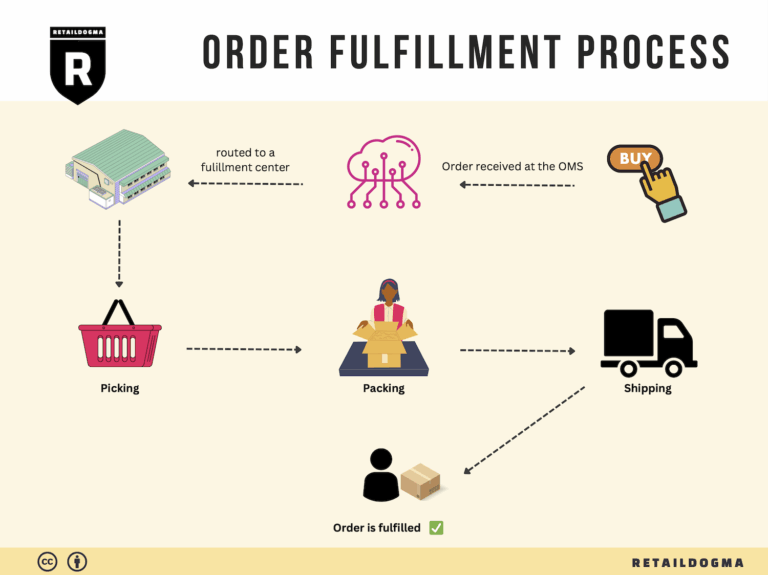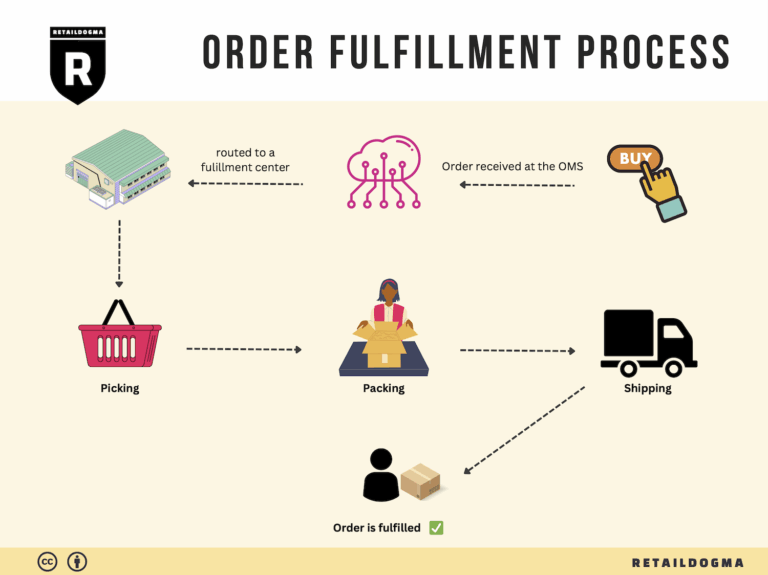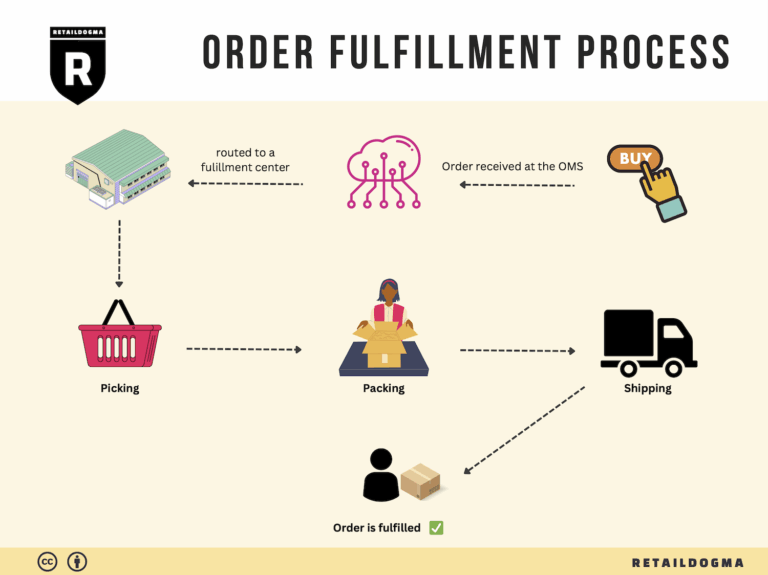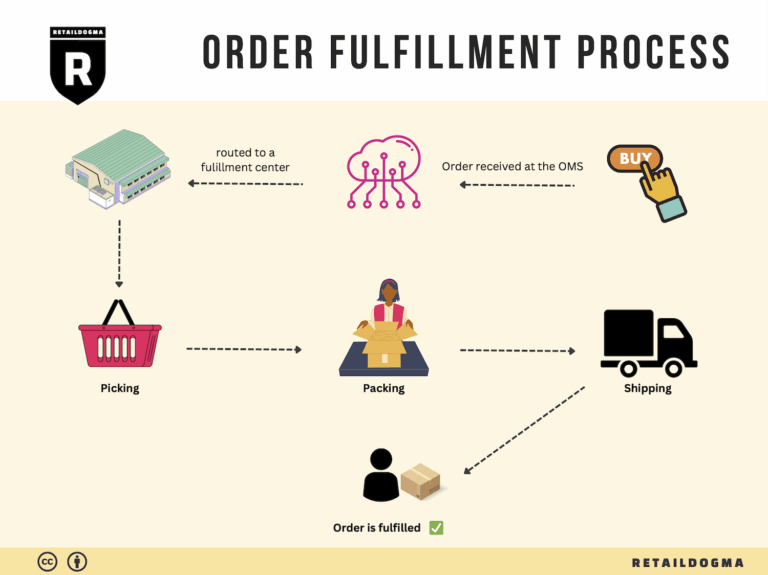How Order Fulfillment Works: A Step-by-Step Guide for Businesses
What is E-commerce Fulfillment? An Introduction for Growing Businesses
Understanding E-commerce Fulfillment for Growing Businesses
As an e-commerce business owner, you may find yourself grappling with the complexities of packing and shipping orders. The excitement of growing sales can quickly become overwhelming when faced with the logistical challenges of fulfilling customer demands. This is where effective e-commerce fulfillment comes into play, serving as the backbone of your online business.
At its core, fulfillment is the process of getting a product from your inventory to the customer’s doorstep. It encompasses everything from receiving orders and picking items from shelves to packing them securely and managing their shipment. As your business scales, the need for a streamlined fulfillment process becomes crucial for maintaining customer satisfaction and operational efficiency.
In this guide, we will explore the various models of e-commerce fulfillment that can support your growth. You will learn about Third-Party Logistics (3PL) providers and Fulfillment by Amazon (FBA), among other options, each with its own strengths and weaknesses. Understanding these models will help you identify which aligns best with your business goals and customer expectations.
We will also delve into the core services involved in fulfillment, including inventory management, order processing, packing, shipping, and returns handling. Knowing what services are available will enable you to select a fulfillment partner that meets your specific needs, ensuring that your operations run smoothly.
Choosing the right fulfillment partner is a critical decision that can significantly impact your business’s success. We will provide practical advice on evaluating potential partners, including key factors to consider such as their technology capabilities, geographical reach, and customer service quality.
Lastly, we will discuss pricing structures associated with different fulfillment options. Understanding how costs are calculated will empower you to make informed decisions that align with your budget while still delivering excellent service to your customers.
The goal of this guide is to equip you with the knowledge and insights needed to make smart decisions about your logistics strategy. By optimizing your e-commerce fulfillment process, you can focus on what you do best—growing your business and delighting your customers. Let’s dive in and explore how you can transform your fulfillment operations into a competitive advantage.
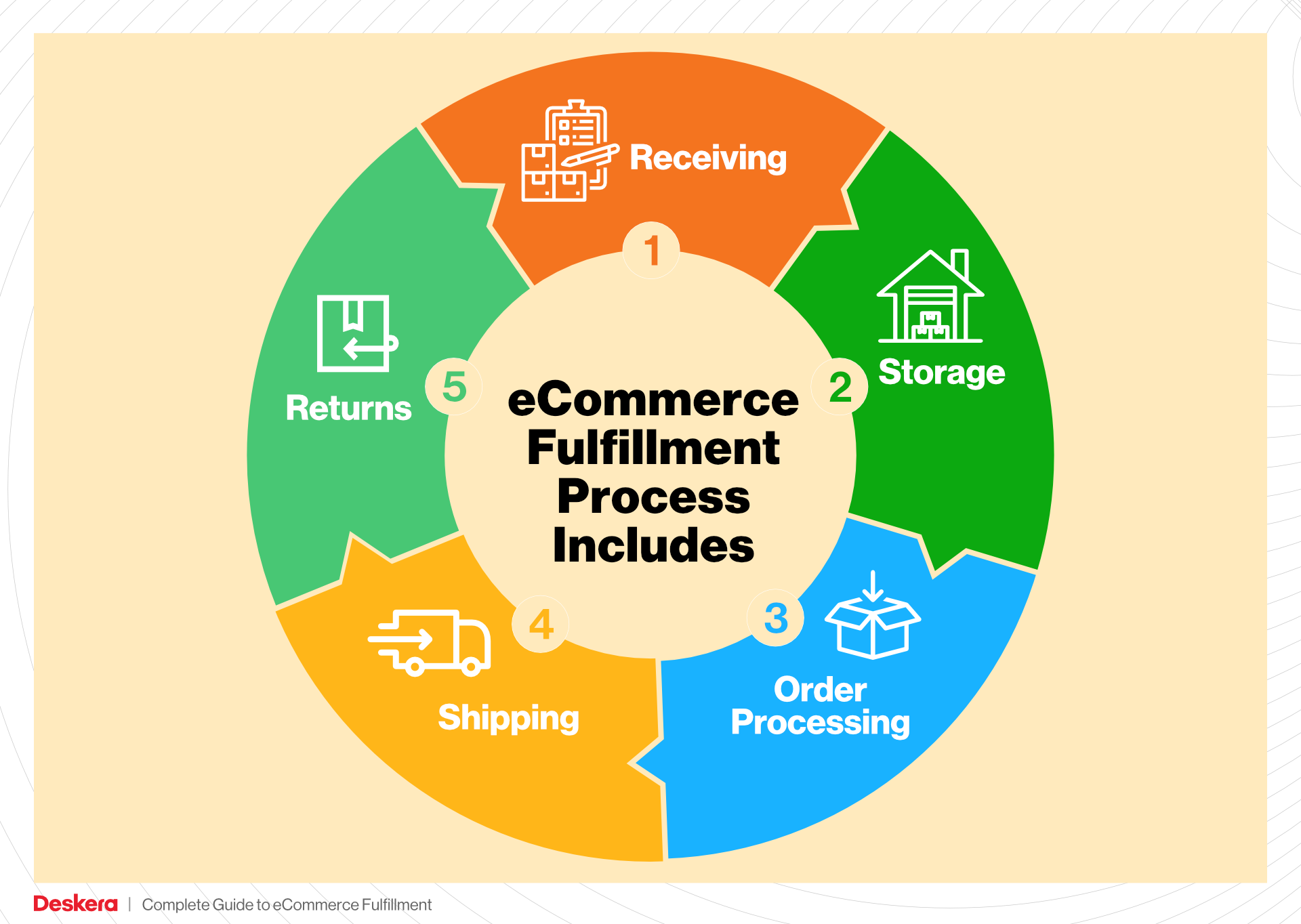
What You’ll Learn In This Guide
- What is E-commerce Fulfillment? An Introduction for Growing Businesses
- The Order Fulfillment Process: From ‘Buy’ Button to Customer’s Door
- Comparing Fulfillment Models: In-House vs. 3PL vs. Dropshipping
- A Deep Dive into Amazon FBA: Pros, Cons, and Who It’s For
- Core Services Offered by Fulfillment Centers
- How to Choose a Fulfillment Partner: A 6-Point Checklist
- Understanding Fulfillment Pricing: A Breakdown of Common Fees
- Frequently Asked Questions (FAQs) about Fulfillment
- Conclusion: Is Outsourcing Fulfillment the Right Move for Your Business?
- Important Disclaimer
The Order Fulfillment Process: From ‘Buy’ Button to Customer’s Door
1. Receiving Inventory
The order fulfillment process begins with receiving inventory, a crucial step that sets the stage for efficient operations. During this phase, products are delivered to the fulfillment center and must be checked against purchase orders to ensure accuracy. This involves verifying quantities, inspecting for damage, and confirming that the received items match the expected specifications.
Importance: Accurate inventory receiving is vital for maintaining stock integrity and preventing discrepancies that can lead to delays in order fulfillment. If the inventory is not received correctly, it can disrupt the entire supply chain, leading to stockouts or overstock situations.
Key Term: SKU (Stock Keeping Unit) – Each product is assigned a unique SKU to track inventory levels and facilitate the management of stock throughout the fulfillment process.
2. Warehouse Storage
Once inventory is received, the next step is warehouse storage. In this phase, products are organized within the fulfillment center for easy access and efficient order processing. This can involve categorizing items based on size, type, or demand to optimize space and improve picking speed.
Importance: Effective warehouse storage is essential for minimizing the time required to locate and retrieve items during order picking. A well-organized warehouse can significantly enhance operational efficiency, allowing businesses to scale their fulfillment processes without sacrificing speed or accuracy.
Key Term: ABC Analysis – This inventory categorization technique helps prioritize stock management by classifying items into three categories (A, B, and C) based on their importance and sales volume, ensuring that high-demand items are readily accessible.
3. Order Picking
Order picking is the process of selecting items from the warehouse to fulfill customer orders. This can be accomplished through various methods, including single order picking, batch picking, or zone picking, depending on the fulfillment center’s size and order volume.
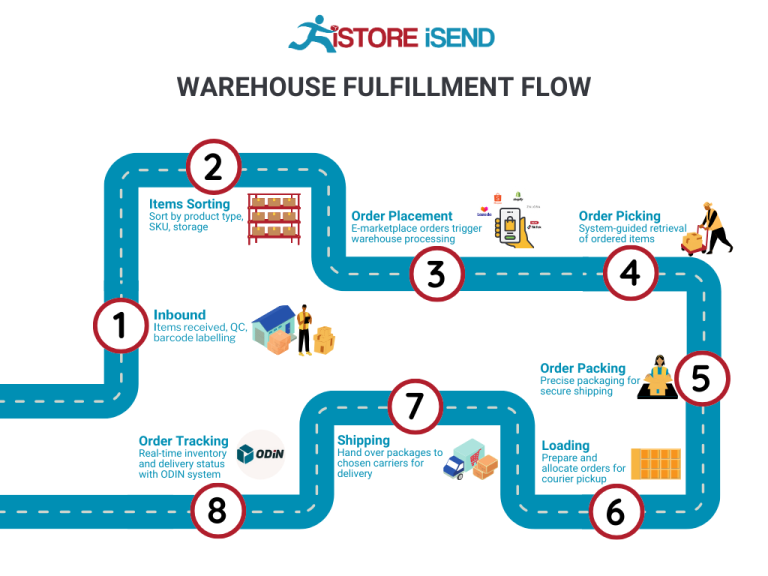
Importance: Efficient order picking is critical to maintaining customer satisfaction, as it directly impacts delivery speed and accuracy. Delays or errors during picking can lead to incorrect shipments, resulting in returns, increased costs, and diminished customer trust.
Key Term: Pick Lists – These are documents or digital lists that outline the specific items and quantities to be picked for each order, guiding warehouse associates through the picking process to ensure accuracy and efficiency.
4. Order Packing
After items have been picked, they move to the packing stage. Here, products are carefully packed into boxes or containers, ensuring they are secure and protected for transit. This stage may involve weighing and measuring items to determine the appropriate packaging, as well as including any necessary documentation, such as packing slips.
Importance: Proper packing is essential for preventing damage during shipping and ensuring that customers receive their orders in excellent condition. Additionally, efficient packing can help minimize shipping costs by optimizing box sizes and reducing wasted space.
Key Term: Fit-to-Order Packaging – This method involves customizing packaging based on the dimensions of the items being shipped, which not only reduces material waste but also enhances the overall shipping experience.
5. Shipping & Delivery
The final step in the order fulfillment process is shipping and delivery. Once orders are packed, they are labeled and handed off to carriers for transportation to the customer’s address. This step often involves selecting the most efficient shipping method based on factors like cost, delivery speed, and destination.
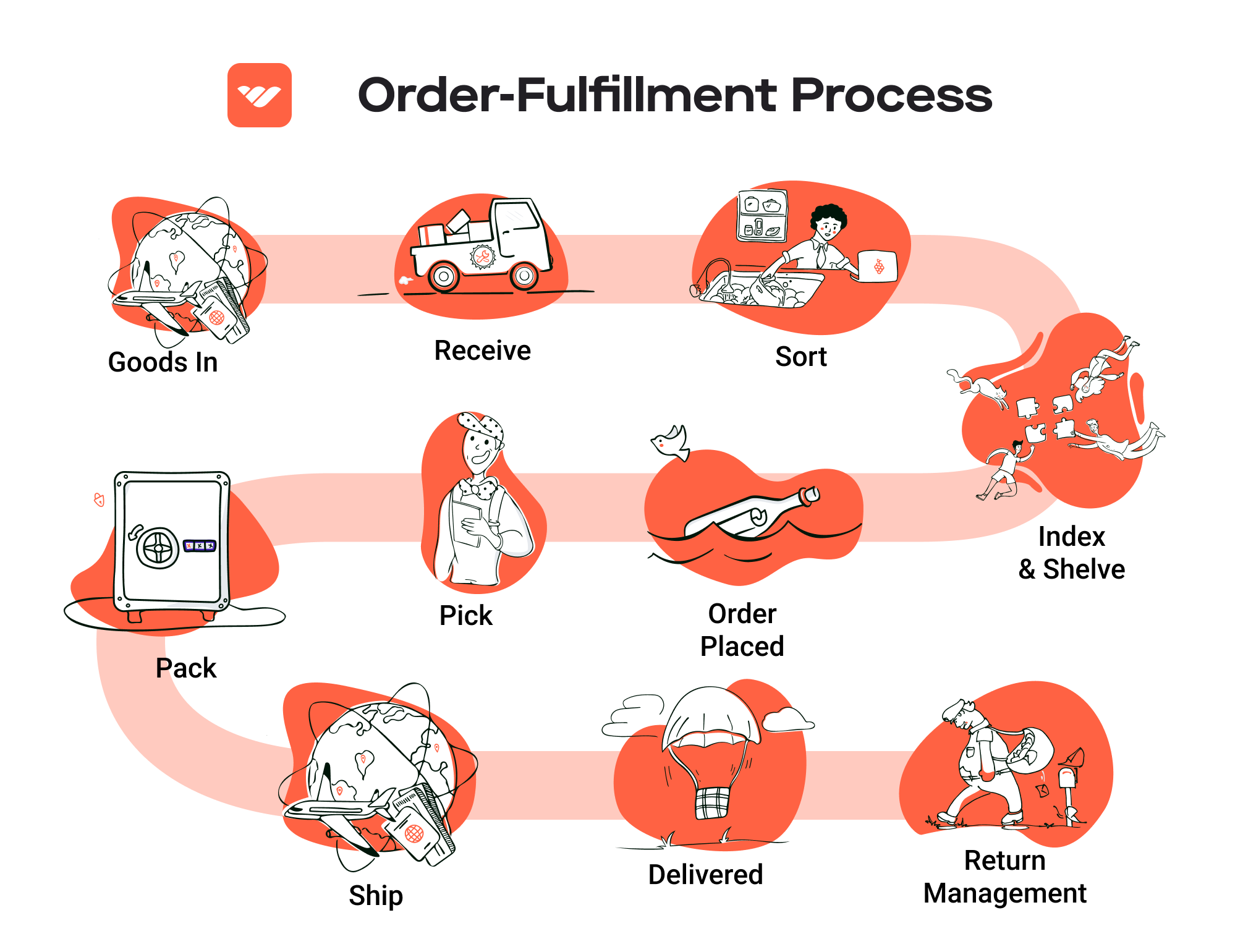
Importance: Timely and reliable delivery is a key factor in customer satisfaction and retention. A well-managed shipping process can lead to repeat business and positive reviews, while delays or issues can harm a brand’s reputation.
Key Term: Last-Mile Delivery – This term refers to the final step of the delivery process, where the package is transported from a distribution center to the customer’s doorstep. Efficient last-mile delivery is crucial for enhancing the overall customer experience and meeting delivery expectations.
By understanding and optimizing each of these five steps, e-commerce businesses can streamline their order fulfillment processes, reduce costs, and ultimately improve customer satisfaction as they scale their operations.
Comparing Fulfillment Models: In-House vs. 3PL vs. Dropshipping
Fulfillment Model Comparison
| Model | Who Handles Inventory | Best For (Business Stage) | Key Advantage | Key Disadvantage |
|---|---|---|---|---|
| In-House Fulfillment | Business itself | Established businesses | Complete control over operations | High overhead costs and resource demands |
| Third-Party Logistics (3PL) | Third-party provider | Growing businesses | Scalable and flexible solutions | Less control over the fulfillment process |
| Dropshipping | Supplier/manufacturer | Startups and small businesses | Low upfront investment and risk | Lower profit margins and dependency on suppliers |
In-House Fulfillment
In-house fulfillment is a model where the e-commerce business manages its inventory, storage, and shipping processes directly. This approach is often favored by established businesses that have the infrastructure and resources to handle logistics internally. The primary advantage of in-house fulfillment is the control it offers. Businesses can manage every aspect of the fulfillment process, from inventory management to packing and shipping, which allows for tailored solutions and consistent quality. Additionally, having direct oversight can lead to quicker response times and improved customer service, as businesses can directly address issues as they arise.
However, in-house fulfillment comes with significant challenges. The costs associated with maintaining warehouses, hiring staff, and managing logistics can be high, leading to increased overhead. Moreover, as order volumes fluctuate, businesses may find it difficult to scale operations efficiently. This model also requires substantial investment in technology and infrastructure, making it less viable for startups or smaller businesses that may not have the capital to invest upfront. Therefore, while in-house fulfillment can be effective, it is best suited for established companies looking to maintain control over their supply chain.
Third-Party Logistics (3PL)
Third-party logistics (3PL) involves outsourcing logistics services to a specialized provider. This model is particularly beneficial for growing businesses that want to scale without the burden of managing logistics themselves. A 3PL provider handles inventory management, warehousing, order fulfillment, and shipping, allowing businesses to focus on their core operations such as marketing and sales. The key advantage of utilizing 3PL is the scalability and flexibility it offers. Businesses can quickly adapt to changing market demands without the need to invest in additional infrastructure or staff.
However, this model also has its disadvantages. When outsourcing fulfillment, businesses relinquish some control over the logistics process, which can lead to inconsistencies in service quality. Issues such as delayed shipments or inventory inaccuracies can arise, impacting customer satisfaction. Additionally, while 3PL can reduce operational burdens, businesses must carefully select a provider to ensure alignment with their brand values and customer service standards. Therefore, 3PL is an ideal solution for growing businesses looking to expand their reach without overwhelming their existing resources.
Dropshipping
Dropshipping is a fulfillment model where businesses sell products without holding inventory. Instead, when a customer places an order, the business purchases the item from a third-party supplier who then ships it directly to the customer. This model is particularly attractive for startups and small businesses due to its low upfront investment and minimal risk. Businesses can offer a wide range of products without the need for significant capital to purchase inventory, allowing for a more flexible and agile operation.
While dropshipping offers several advantages, it also has notable drawbacks. The primary disadvantage is the lower profit margins typically associated with this model, as businesses must pay wholesale prices to suppliers. Additionally, the reliance on suppliers can lead to issues with stock availability, shipping times, and product quality, which can negatively affect customer satisfaction. Businesses may also face challenges in brand differentiation, as many other retailers may sell the same products from the same suppliers. For these reasons, dropshipping is best suited for those looking to test markets or enter new niches without significant financial commitment, but it requires careful management of supplier relationships and customer expectations.
In summary, each fulfillment model presents unique advantages and disadvantages that businesses must consider based on their specific circumstances, growth stage, and operational capabilities. By understanding these differences, e-commerce business owners can make informed decisions that align with their goals and resources.
A Deep Dive into Amazon FBA: Pros, Cons, and Who It’s For
Understanding Fulfillment by Amazon (FBA)
Fulfillment by Amazon (FBA) is a service offered by Amazon that allows sellers to store their products in Amazon’s fulfillment centers. Amazon takes care of storage, packaging, and shipping of products to customers. This service also includes customer service and returns management, enabling sellers to focus more on growing their business rather than on logistics.
When a customer orders a product, Amazon picks, packs, and ships the item on behalf of the seller. Sellers benefit from Amazon’s vast distribution network, allowing them to reach millions of customers efficiently. By utilizing FBA, sellers can make their products eligible for Amazon Prime and other Amazon services, which enhances the visibility and attractiveness of their listings.
How FBA Works
-
Setting Up an FBA Account: Sellers first need to create an Amazon Seller account and enroll in the FBA program. This process involves listing products that will be fulfilled by Amazon.
-
Shipping Inventory to Amazon: Sellers send their products to Amazon’s fulfillment centers. Amazon provides guidance on how to prepare and package these products to ensure they are suitable for storage and shipment.
-
Product Storage: Once received, products are stored in Amazon’s warehouses. Amazon manages the inventory, ensuring that items are available for quick shipping.
-
Order Processing: When a customer places an order, Amazon takes care of the entire fulfillment process. This includes picking the item from the warehouse, packing it, and shipping it directly to the customer.
-
Customer Service and Returns: Amazon handles customer inquiries and returns for FBA products, which frees up sellers from these responsibilities.
Pros of Using FBA
1. Prime Eligibility
One of the most significant advantages of FBA is that products fulfilled by Amazon automatically qualify for Amazon Prime. This means Prime members can receive free two-day shipping, making your products more appealing to a vast customer base. The Prime badge enhances trust and credibility, often leading to increased sales.
2. Customer Trust and Brand Credibility
When customers see that a product is fulfilled by Amazon, they often feel more secure about making a purchase. Amazon’s reputation for reliable shipping and customer service can help boost the credibility of sellers’ brands.
3. Multi-Channel Fulfillment
FBA is not limited to Amazon sales. Sellers can use FBA to fulfill orders from other platforms, such as their own websites or eBay. This multi-channel fulfillment capability allows for streamlined logistics and inventory management across various sales channels.
4. Scalability
FBA allows sellers to scale their operations without the need to invest in warehouse space or staff. As sales increase, Amazon handles the logistics, allowing sellers to focus on marketing and product development.
5. Advanced Logistics and Shipping Solutions
Amazon’s sophisticated logistics network means that orders are processed quickly and efficiently. Sellers benefit from Amazon’s shipping rates, which are often lower than what they could secure independently.
Cons of Using FBA
1. High Fees
While FBA offers many benefits, it comes with substantial fees, including storage fees and fulfillment fees. These costs can add up quickly, especially for sellers with slow-moving inventory or those selling lower-priced items.
2. Strict Inventory Management Rules
Amazon has specific requirements for inventory management, including limits on the quantity of products that can be stored in their warehouses. Sellers must be diligent in managing their inventory levels to avoid excess storage fees or having their products removed from the platform.
3. Commingling Risks
FBA uses a commingling method where inventory from different sellers is stored together. This can pose risks for sellers, as it may lead to issues with counterfeit goods or damaged items. If a seller’s product is commingled with a defective or counterfeit item, it can affect their seller rating and lead to customer dissatisfaction.
4. Limited Control Over Shipping
When using FBA, sellers relinquish control over the shipping process. This means they cannot personalize packaging or include marketing materials in shipments, which can affect brand visibility and customer engagement.
5. Complex Returns Process
While Amazon handles returns, the process can be complex for sellers. Returned items may not always be in sellable condition, and managing returns can be cumbersome, especially for smaller sellers.
Who is FBA Best For?
FBA is ideally suited for e-commerce business owners who want to scale their operations without the burden of logistics. It is particularly beneficial for:
-
Small to Medium-Sized Sellers: Those who lack the resources to manage fulfillment and logistics independently can leverage Amazon’s infrastructure.
-
Brands Looking for Exposure: Sellers seeking to increase visibility and credibility through Prime membership and Amazon’s trusted shipping services.
-
Multi-Channel Sellers: Businesses that sell on multiple platforms and need a streamlined fulfillment process can benefit from FBA’s multi-channel capabilities.
-
Product-Based Businesses with High Turnover: Sellers with products that have a high turnover rate can maximize the benefits of FBA by minimizing storage fees and taking advantage of Amazon’s fast shipping.
In conclusion, FBA offers a powerful solution for many e-commerce businesses, providing the ability to reach a vast customer base while minimizing the complexities of logistics. However, it is essential for sellers to weigh the pros and cons carefully and consider their specific business needs before committing to the program.
Core Services Offered by Fulfillment Centers
Inventory Management & Warehousing
Inventory management and warehousing are foundational services provided by fulfillment centers, enabling e-commerce businesses to maintain optimal stock levels and efficiently store products. Fulfillment centers utilize advanced inventory management systems that offer real-time tracking and analytics. This allows businesses to know exactly what products are in stock, their location within the warehouse, and when they need to be replenished.
The benefits of effective inventory management are manifold. First, it minimizes the risk of stockouts, which can lead to lost sales and dissatisfied customers. By having a clear view of inventory levels, businesses can make informed purchasing decisions, preventing excess inventory that ties up capital. Furthermore, modern warehousing solutions often include climate control and security measures, ensuring that products are stored safely and in optimal conditions, particularly for sensitive items.
For e-commerce businesses looking to scale, partnering with a fulfillment center that offers robust inventory management capabilities can lead to significant operational efficiencies, allowing owners to focus on growth strategies rather than day-to-day inventory concerns.
Pick and Pack Services
Pick and pack services are crucial for any fulfillment operation, as they involve selecting items from inventory based on customer orders and preparing them for shipment. Fulfillment centers streamline this process using technology such as barcode scanning and automated picking systems, which enhance speed and accuracy.
The primary benefit of efficient pick and pack services is the reduction of order processing times. Fast and accurate fulfillment can significantly enhance customer satisfaction, as consumers increasingly expect quick delivery times. For businesses, this can translate into higher conversion rates and repeat purchases. Additionally, accurate packing minimizes errors and reduces the likelihood of returns, further streamlining operations.
By outsourcing pick and pack services to a fulfillment center, e-commerce businesses can scale their operations without the overhead costs of hiring and training staff for these tasks. This flexibility allows businesses to respond quickly to fluctuating demand and seasonal spikes.
Kitting and Assembly
Kitting and assembly are specialized services that involve grouping various products into a single package or assembling components into a finished product. This service is particularly beneficial for businesses offering subscription boxes, promotional bundles, or customizable products. Fulfillment centers can efficiently handle the complexities of kitting, ensuring that all items are included and packaged correctly.
The advantage of utilizing kitting services lies in the potential for increased average order value (AOV). By bundling products together, businesses can encourage customers to purchase more items at once, enhancing the overall shopping experience. Moreover, kitting can streamline inventory management by consolidating multiple SKUs into a single packaged unit, simplifying storage and order fulfillment.
For e-commerce brands looking to differentiate themselves in a competitive market, offering unique kits or assembled products can create a more compelling value proposition, attracting new customers and retaining existing ones.
Returns Management (Reverse Logistics)
Returns management, or reverse logistics, is an essential service that addresses the complexities of handling product returns. Fulfillment centers often provide streamlined processes for receiving returned items, inspecting them for quality, restocking them if possible, and processing refunds or exchanges. This is particularly important in the e-commerce sector, where return rates can be significantly higher than in traditional retail.
The benefits of efficient returns management are substantial. By handling returns professionally, fulfillment centers can enhance customer satisfaction and loyalty. A hassle-free return process encourages customers to shop with confidence, knowing that they can easily return items that do not meet their expectations. Additionally, effective reverse logistics can help businesses recover value from returned products, whether through restocking, refurbishment, or resale.
Outsourcing returns management to a fulfillment center allows e-commerce businesses to focus on core operations while ensuring that returns are processed quickly and efficiently. As the online shopping landscape continues to evolve, having a robust returns management system in place is vital for maintaining a competitive edge.
By leveraging these core services offered by fulfillment centers, e-commerce businesses can optimize their operations, enhance customer satisfaction, and position themselves for scalable growth in an increasingly demanding marketplace. Each service plays a crucial role in streamlining logistics, improving efficiency, and ultimately driving sales.
How to Choose a Fulfillment Partner: A 6-Point Checklist
Location & Warehouse Network
Importance: The geographical location of your fulfillment partner’s warehouses is critical for optimizing shipping times and costs. A partner with strategically placed distribution centers can significantly reduce delivery times, enhance customer satisfaction, and lower shipping expenses.
Questions to Ask:
– Where are your fulfillment centers located?
– How do you determine the locations of your warehouses?
– Can you provide coverage maps that show delivery times to key markets?
– Do you have plans for expanding your warehouse network in the near future?
Technology & Integrations
Importance: The technology used by your fulfillment partner can make or break your logistics operations. A partner with advanced technology can streamline processes, improve accuracy, and provide real-time tracking, which is essential for maintaining customer trust and satisfaction.
Questions to Ask:
– What technology platforms do you use for order management and inventory tracking?
– Can your systems integrate with our existing e-commerce platforms (e.g., Shopify, WooCommerce)?
– Do you offer real-time reporting and analytics tools for monitoring order fulfillment?
– How do you handle data security and ensure compliance with regulations?
Specializations (e.g., Cold Storage, Oversized Items)
Importance: Depending on your product offerings, you may require a partner with specialized capabilities, such as cold storage for perishable goods or facilities for handling oversized items. Ensuring that your fulfillment partner can accommodate your specific needs is crucial for maintaining product quality and compliance.
Questions to Ask:
– Do you have specialized facilities for handling unique product types (e.g., perishable, fragile, oversized)?
– What safety and quality control measures do you have in place for specialized inventory?
– Can you handle seasonal fluctuations in demand for specialized products?
– Have you worked with businesses in our industry before? Can you provide references?
Scalability & Capacity
Importance: As your business grows, your fulfillment partner should be able to scale operations accordingly. A partner with sufficient capacity can handle increased order volumes without compromising service levels, making it essential to evaluate their scalability.
Questions to Ask:
– What is your current capacity for handling orders, and how do you plan to scale?
– How do you manage peak seasons or unexpected surges in demand?
– Can you accommodate our growth plans over the next 1-3 years?
– What contingency plans do you have in place for unforeseen circumstances, such as natural disasters or supply chain disruptions?
Pricing and Contracts
Importance: Understanding the pricing structure and contract terms is vital for budgeting and financial planning. Transparent pricing helps avoid unexpected costs and ensures you can effectively manage your margins.
Questions to Ask:
– What is your pricing model (e.g., per order, per item, monthly fees)?
– Are there any hidden fees we should be aware of (e.g., storage, handling, returns)?
– What are the terms and conditions of the contract, including cancellation policies?
– How often do you reassess pricing, and what factors can lead to price increases?
Customer Support & Reviews
Importance: Reliable customer support is essential for addressing any issues that may arise during the fulfillment process. Additionally, checking reviews and testimonials can provide insights into a partner’s reliability and service quality.
Questions to Ask:
– What customer support channels do you offer (e.g., phone, email, chat)?
– What are your response times for customer inquiries or issues?
– Can you provide references or testimonials from current or past clients?
– How do you handle disputes or service level failures?
Conclusion
Choosing the right fulfillment partner is a critical decision that can impact your e-commerce business’s efficiency, customer satisfaction, and overall growth trajectory. By using this checklist, you can systematically evaluate potential partners to ensure they align with your operational needs and long-term goals.
Understanding Fulfillment Pricing: A Breakdown of Common Fees
Initial Setup Fees
When partnering with a fulfillment center, businesses often encounter initial setup fees. These fees cover the costs associated with onboarding your products into the fulfillment system. This may include account creation, integrating your e-commerce platform, and training personnel on your specific product handling needs.
The calculation of initial setup fees can vary significantly between providers. Some fulfillment centers may charge a flat fee, while others may base their fees on the complexity of the integration or the number of products being set up. It’s crucial to clarify what services are included in these fees and whether any additional charges may apply for special requirements, such as custom packaging or unique inventory management systems.
Receiving Fees
Receiving fees are charged when your products arrive at the fulfillment center. This fee covers the labor and resources needed to unload, inspect, and store your inventory.
Typically, receiving fees can be calculated on a per-pallet or per-sku basis. For example, a fulfillment center may charge a fixed rate for each pallet received or a fee for each individual SKU that requires special handling. Understanding the specifics of how receiving fees are structured can help you estimate overall costs, especially if you anticipate fluctuating inventory levels.
Storage Fees (per pallet/bin)
Storage fees are incurred for the space your products occupy within the fulfillment center. These fees are typically calculated on a per-pallet or per-bin basis, with rates varying depending on the location and size of the fulfillment center.
Most fulfillment centers will charge monthly storage fees, which can be influenced by several factors, including the size of your inventory and the duration for which it is stored. It’s essential to inquire about potential tiered pricing structures—some centers offer reduced rates for larger volumes or longer commitments, which can be beneficial for businesses looking to scale.
Pick & Pack Fees (per item/order)
Pick and pack fees are charged for the labor involved in selecting items from inventory and preparing them for shipment. This fee can be based on several factors, including the number of items in an order, the complexity of packing requirements, and the frequency of orders.
Fulfillment centers may charge a flat rate per order or a variable fee based on the number of items picked. Additionally, businesses should be aware of potential surcharges for special packing materials or processes, such as gift wrapping or fragile item handling. Understanding how pick and pack fees are structured is crucial for managing your overall fulfillment costs.
Shipping Fees
Shipping fees represent one of the most significant expenses in the fulfillment process. These fees cover the cost of transporting your products from the fulfillment center to the customer. Shipping fees can vary widely based on several factors, including the shipping carrier, the destination, package weight and dimensions, and the chosen delivery speed.
Most fulfillment centers will provide multiple shipping options, allowing businesses to select the best balance of cost and delivery time. It’s essential to understand the shipping fee structure, as some providers may offer discounted rates for high-volume shipping or partnerships with specific carriers. Additionally, inquire about any hidden fees, such as surcharges for remote deliveries or fuel surcharges.
Tips for Getting an Accurate Quote
-
Detail Your Needs: Provide potential fulfillment partners with comprehensive information about your product types, order volumes, and specific requirements. The more details you share, the more accurate the quote will be.
-
Ask About All Fees: Ensure you understand the full scope of fees involved, including any hidden costs, minimum order requirements, and additional services that may incur extra charges.
-
Compare Quotes: Don’t settle for the first quote you receive. Compare offers from multiple fulfillment centers to identify the best overall value, taking into account service quality and reliability.
-
Negotiate: Many fulfillment centers are open to negotiation, especially for long-term contracts or higher volumes. Don’t hesitate to ask for discounts or better terms.
-
Review Contracts Carefully: Before signing any agreement, thoroughly review the terms and conditions related to pricing. Look for clauses that might affect your costs, such as price increases or service limitations.
By understanding these common fulfillment pricing models and following these tips, you can better navigate the complexities of fulfillment pricing and make informed decisions that support your e-commerce growth.
Frequently Asked Questions (FAQs) about Fulfillment
1. What is a fulfillment center and how does it differ from a warehouse?
A fulfillment center is a specialized facility designed to handle the storage, packing, and shipping of products for e-commerce businesses. While both fulfillment centers and warehouses are used for storage, fulfillment centers focus on efficiently processing orders and fulfilling customer needs. They often incorporate advanced technology and systems to streamline operations, whereas warehouses primarily serve as storage locations with less emphasis on order processing.
2. How does Sam’s Club’s fulfillment center operate?
Sam’s Club’s fulfillment centers utilize a combination of traditional warehousing and innovative technology to manage inventory and fulfill orders. The centers are designed to expedite order processing by allowing associates to pick, pack, and ship products directly from the club’s inventory. This model supports faster delivery times and enhances the overall shopping experience for members.
3. What is a 3PL (Third-Party Logistics) provider?
A 3PL provider is a company that offers outsourced logistics services, which can include transportation, warehousing, inventory management, and fulfillment services. Businesses partner with 3PLs to leverage their expertise and resources for efficient supply chain management, reducing operational costs and allowing businesses to focus on core activities.
4. What types of products can be fulfilled through Sam’s Club fulfillment centers?
Sam’s Club fulfillment centers handle a wide range of products, including shelf-stable goods, groceries, and general merchandise. The centers are equipped to manage both online orders for home delivery and curbside pickup, ensuring that members have access to a diverse selection of items.
5. How much do fulfillment services cost?
The cost of fulfillment services can vary significantly based on several factors, including order volume, storage needs, and the complexity of the fulfillment process. Typically, businesses can expect to pay for services that include storage fees, picking and packing fees, and shipping costs. It’s advisable to obtain quotes from multiple providers to compare pricing and services offered.
6. What are the benefits of using Sam’s Club for fulfillment services?
Utilizing Sam’s Club’s fulfillment services offers several advantages, such as access to an extensive network of distribution centers, reduced shipping times, and the ability to leverage Sam’s Club’s existing infrastructure and technology. Additionally, the “Ship from Club” initiative allows for quick order fulfillment directly from club inventory, enhancing customer satisfaction.
7. How does Sam’s Club ensure fast delivery times?
Sam’s Club invests in expanding its fulfillment network, including the opening of new distribution centers and implementing advanced technologies like automation and robotics. These efforts are designed to enhance operational efficiency, reduce order processing times, and ensure timely deliveries to customers.
8. What role does technology play in Sam’s Club’s fulfillment centers?
Technology is integral to the operations of Sam’s Club’s fulfillment centers. The company employs systems such as 3D visualization packing software and automated fit-to-order packaging, which streamline the packing process, reduce errors, and optimize shipping materials. This technological integration not only improves efficiency but also enhances the overall customer experience.
9. How does Sam’s Club manage inventory for online orders?
Sam’s Club utilizes a sophisticated inventory management system that allows for real-time tracking and management of stock levels across its fulfillment centers. By integrating inventory data with order management systems, the company can efficiently allocate products for online orders, ensuring that items are available for prompt shipping.
10. What should businesses consider when choosing a fulfillment partner?
When selecting a fulfillment partner, businesses should evaluate factors such as the provider’s location, technology capabilities, service offerings, pricing structure, and customer service reputation. It’s essential to choose a partner that aligns with your business needs and can scale operations as your e-commerce sales grow.
Conclusion: Is Outsourcing Fulfillment the Right Move for Your Business?
Evaluating the Benefits of Outsourcing Fulfillment
As e-commerce continues to evolve, many businesses are turning to fulfillment services as a strategic move to streamline operations and enhance customer satisfaction. The key benefits of outsourcing fulfillment include significant time savings, scalability, and access to specialized expertise. By partnering with an established fulfillment center, such as those being developed by Sam’s Club, businesses can focus on core activities like marketing and product development while leaving the complexities of logistics to professionals.
Outsourcing fulfillment allows businesses to scale operations efficiently. As demand fluctuates, fulfillment partners can quickly adjust to changes, whether it’s ramping up during peak seasons or scaling down during quieter periods. This flexibility is crucial for businesses aiming to maintain customer satisfaction without overextending their resources.
Moreover, fulfillment centers bring a wealth of expertise in logistics management, inventory control, and shipping optimization. With advanced technologies and automated systems, these centers can handle your shipping processes more efficiently than in-house teams. This not only reduces the likelihood of errors but also enhances the speed of delivery, a critical factor in today’s competitive market.
However, the success of outsourcing fulfillment heavily relies on choosing the right partner. A misalignment in values, capabilities, or communication can hinder growth rather than promote it. Therefore, it’s essential to conduct thorough research, assess potential partners, and ensure they align with your business goals and customer expectations.
Take Action Today
Consider auditing your current shipping processes and evaluating whether a fulfillment partner could enhance your operations. Analyze your growth projections, logistics challenges, and customer demands. By taking this strategic step, you can determine if outsourcing fulfillment is the right move to scale your business effectively and sustainably.
Important Disclaimer
⚠️ Important Disclaimer
The information in this guide is for educational purposes. Fulfillment services, pricing, and platform features change frequently. Always conduct your own due diligence and consult with providers directly before making business decisions.

